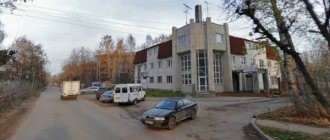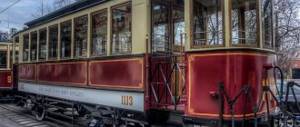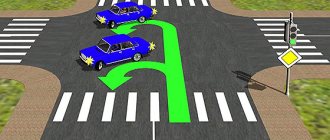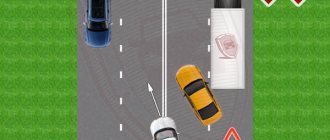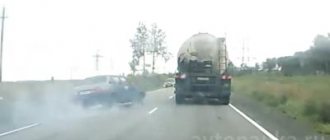Hello everybody! Different situations happen on the roads. Drivers are faced with the need to turn, turn around, and continue driving straight. A pressing issue today will be turning around from the adjacent territory.
Some motorists do not quite correctly interpret this maneuver. This leads to various unpleasant traffic situations.
To do everything according to the law, and at the same time fully complete the reversal, you should study the issue in detail.
U-turn at an intersection (controlled or unregulated)
One of the most difficult maneuvers. At first glance, this maneuver differs little from two consecutive left turns. The only problem is that the movement of drivers and pedestrians at the intersection is often very complicated, and you don’t very well understand who and how to let pass (according to traffic rules, and not “according to concepts”), which side to pass with cars making an oncoming maneuver. Plus, if the intersection is controlled, it is often not possible to make a U-turn in one traffic light cycle. Additionally, the situation can be complicated, for example, by the presence of pedestrian crossings (“zebra crossings”); hitting a “zebra crossing” (not necessarily with a wheel, a bumper or mirror is enough) can lead to failure of the exam. If there are such intersections in your exam area and you are asked to turn around at them, you need to practice turning at the intersection (do the maneuver several times). Always remember that at intersections it is unacceptable to “cut corners”; you always need to get into your lane. And keep in mind that the situation greatly depends on the car; the larger the car, the more difficult it is to carry out such a maneuver (for example, it is difficult to avoid hitting a zebra crossing).
A car for driving lessons and exams in the traffic police
The concept of adjacent territory
Every car enthusiast understands that it is easier to make a U-turn in a clear space from cars than to carry out the same maneuver on a narrowed road. To understand how to turn around correctly, you need to carefully study paragraph 1. 2 of the traffic rules.
It says here that the adjacent territory is a certain area connected to the main road nearby, but not intended for through traffic. We are talking about:
- parking lots;
- gas stations;
- courtyard areas.
Such areas are visited several times a day.
Inexperienced drivers often confuse the surrounding area with an intersection. This leads to violation of established rules and causes road accidents.
To avoid emergency situations, every driver must know what distinctive features characterize the adjacent area. Here are the most basic of them:
- there is no traffic light on the territory;
- there are no special signs that are usually installed at intersections;
- The territory is secondary, therefore, when making a turn, you must follow rules that differ from those at an intersection.
Light bulb spread
The most difficult version of a U-turn at an intersection is a “light bulb” U-turn. In this way, you have to turn around when, when trying to make a turn in the standard way, the car does not fit into the dimensions of the road. The peculiarity of the “light bulb” turn is that instead of taking the extreme left position on the lane and immediately turning, you have to first go to the right and only then start the turn (in this way the turning radius increases). How to make a U-turn at an intersection depends on the turning radius of a particular car - a compact car can make a U-turn in the standard way, but a large car can only make a “light bulb” turn.
Video demonstrating similar “light bulb” turns on the examination route of the State Traffic Safety Inspectorate:
You can read about the MREO, on whose examination route this video was recorded here:
Moscow MREO STSI Lobnenskaya - exam route, instructor for training on the exam route, reviews
Turning outside an intersection (“in one step”)
With complex maneuvers, it is very important to understand where they are possible and where they are not, so study the theory well - you will not have time to think for long. So, with a turn, a very common trick in the exam is to suggest turning around in places where there are all the conditions for a turn, except one, for example, there is no visibility for more than 100 meters (or while you are thinking about what to do, you arrive at such a place).
As a rule, it is impossible to turn around correctly within two lanes, so you need to look for a place with a small “pocket” on the opposite side. The role of a “pocket” can be an exit from the adjacent territory or some area next to the road.
When performing a maneuver, it is critical to turn around with a margin so as not to hit the curb. Moreover, keep in mind that at the slightest suspicion (not necessarily real), the inspector can hit the brakes and interrupt your maneuver.
Naturally, all maneuvers must be indicated with turn signals and all cars that have priority should be allowed to pass (wait for the moment when the car you are letting through will definitely not change speed or direction of movement).
How to make a U-turn correctly
Not only beginners, but also experienced drivers experience difficulties when making a U-turn. However, if you understand the rules, you can avoid unpleasant situations.
Road situation assessment
The driver who needs to turn the vehicle around is obliged to analyze the situation on the road. If there is a large flow of cars, it is easier to maneuver from the adjacent section of the road located on the left side. In this case, there will be a need to yield exclusively to vehicles on only one side.
It is much more difficult to make a turn when the required area is on the right. In this case, the leaving car must give way to traffic moving in both lanes.
If a novice is driving, then this will be quite problematic for him. Therefore, it is important to correctly assess the situation on the road and choose a suitable place to turn around. Otherwise, the lives of not only the driver are at risk, but also those who are on the roadway at that moment.
Use of the area on the right
When making a turn, the driver should adhere to a certain action plan, which is designed specifically to prevent an emergency. If the selected area is on the right side, then first of all you need to turn on the right turn so that other drivers are aware of what is happening.
You should drive a short distance to the selected location (about a meter) and stop the car. For beginners, it is important to remember that it is not recommended to press closely against the curb. During subsequent maneuvers, there is a danger of not calculating the distance and driving into it.
So, when the car is stopped, you need to assess the situation on the road. If there are no obstacles from behind, then slowly drive into the selected area in reverse. The main thing is to let pedestrians pass if they appear on the path of movement.
Once in the right place, the driver must turn left, check whether the roadway is clear, and complete his maneuver.
It is important to remember that before completing the turn and entering the road, you need to stop at the very edge of it. This will allow you to see all the cars that are in close proximity on both lanes.
Adjacent area on the left
The driver needs to change lanes to the far left and stop at the turn that will lead to the required section. Then you need to assess the situation, let traffic that is moving in the opposite direction pass, and enter the territory in front. When performing this action, you need to drive as close as possible to its right side.
When the car has completely disappeared into the area adjacent to the road, you should back up and finish your maneuver.
At this stage, it is important to carefully monitor other road users so as not to turn in their face and provoke an accident. Having approached the road, you need to slow down, look around and smoothly enter the lane, and then go forward.
The maneuver considered is quite simple, however, it contains danger associated with pedestrians. Having made a turn and trying to get to the destination, the driver is in the oncoming lane. If a pedestrian suddenly appears in front of him, the rules oblige him to stop and let him pass. In this case, the car will end up in the middle of the roadway, which will not bring much pleasure to either the driver or other road users.
Reversing
Since a parking lot or yard is also considered adjacent to the roadway, the driver often has to turn around and drive in reverse. Such a maneuver requires special caution, since it will be difficult to see approaching vehicles due to the limited visibility.
If there is more than one driver in the car, he can ask a companion to step out onto the road so that he can be seen and give a sign when he can make a U-turn. He must also use gestures to warn other cars so that they have time to slow down.
However, it is better to carry out such manipulations on not too busy roads, otherwise there will be a threat to the lives of not only the drivers, but also the assistant who is on the road.
Outside the intersection
The maneuver is usually carried out on a road with two lanes, which are separated by a broken line. First you need to turn right, assess the road situation through the rear-view mirrors and gradually press against the curb. Then, having switched the turn signal to the left side, you need to check again for the presence of other cars.
If the path is clear, then move forward with a quick but smooth turn of the steering wheel. After the turn, the steering wheel is leveled and the speed is gradually increased.
However, the left turn signal still remains on.
Turning around using the local area (“in two steps”)
If it is not possible to turn around in “one step,” you will have to turn around in two steps, with reverse gear engaged. The action is very similar to the “boxing drive” exercise. The only problem is that you need to control passing cars and not interfere with them. You must practice confidently doing this maneuver; finding a place to practice is not difficult. Again, do not forget about turn signals and hazard lights when moving backwards (according to traffic regulations, in this case you need to use turn signals, but in many MREOs it is customary to use emergency lights, it makes sense to clarify this issue (local specifics)).
Links to useful materials:
Driving in the city, task setting
Where to study (driving school training route)
Basic driving skills (basic road maneuvers)
Difficult vehicle maneuvering (maneuvers on roads that require special training)
Turn right - what the traffic rules say and what the real situation on the roads is (how drivers with driver’s licenses usually act)
Right turn - how to act during the exam and what the inspector will pay attention to
Registration for exams and retaking exams at the traffic police in a driving school
Registration at the traffic police for the exam and retaking the exam to obtain a driver's license
Alternative options for registering for the exam at the State Traffic Safety Inspectorate (via the State Services website or in person at the REO), how to speed up the exam
Procedure for passing the traffic police exam driving in the city
The traffic police examination route, the road conditions on the route and the features of the maneuvers that will have to be done during the traffic police exam
Published 17.2.2016, version 1.2 from 20.07.2018
Author: Alexander Rulim (Sasha Rulim)
Where U-turns are prohibited
There are several situations in which traffic rules prohibit making a U-turn.
We are talking about the following points:
- A road with one-way traffic
. If you start moving in the opposite direction, you will face a minimum fine of 5 thousand rubles. Or they may deprive the driver of his license for several months. Then he will not be able to accurately repeat such actions; - Crosswalk
. There will also be serious financial punishment. So don't even try; - Bad visibility
. If visibility is less than 100 meters in one direction. In this case, it does not matter at all what exactly causes poor visibility. This may include a sharp turn, as well as weather conditions such as heavy rain, fog or snow; - Solid or double solid markings
. Another prohibitive situation. In fact, when turning, you will have to cross the markings. And this is a direct violation of traffic rules. If there are no broken markings, look for another section of the road to turn around; - Stop
. If performing a maneuver requires entering a public transport stop zone, this will be regarded as an offense.
Yes, such actions will not always be recorded by traffic cameras, as well as by inspectors. But it's not worth the risk.
In addition to the fine, such actions also pose an increased potential threat.
Support Rulims!
If Rulims helped you (simplified the process of obtaining a driver’s license or allowed you to save money in something else, for example, in choosing some devices or receiving some services), help him too, I will be grateful for any amounts, you can transfer either from a bank card or and from Yandex.Money (you must select the desired payment method). The funds received will allow us to develop the resource, raise new topics and possibly offer new services.
If you cannot use the proposed translation methods, please support the Charitable Foundation Tradition, which is close to me. They have access to almost all available methods of receiving funds.
You can also help by publishing a link to Rulims (https://www.rulims.ru) on your favorite social network, blog or forum (I would be especially grateful for blogs and forums, thank you very much in advance). I will also be grateful for participation in groups on social networks and extremely grateful for reposting materials of interest to you on your blogs and forums. Your comments and examples from your experience are also very useful for the development of the project. To comment, it is better to register on Rulims. The registration form on the site is as simple as possible; services are provided only for registered users. You can read more about how you can help the resource on the Support and participation in the project page.
